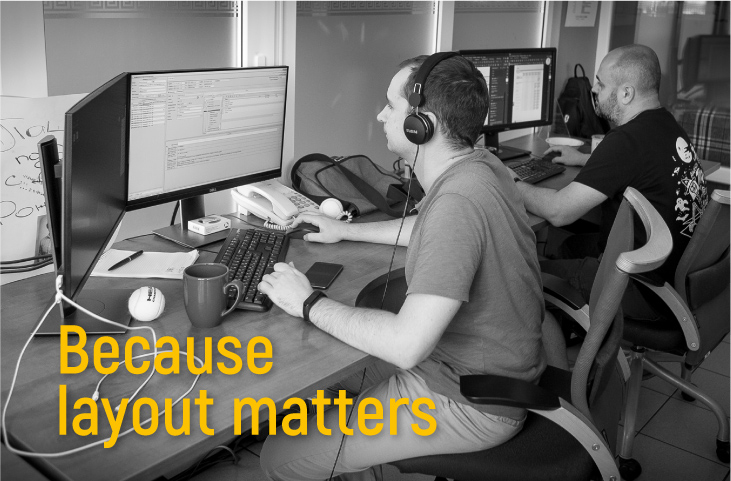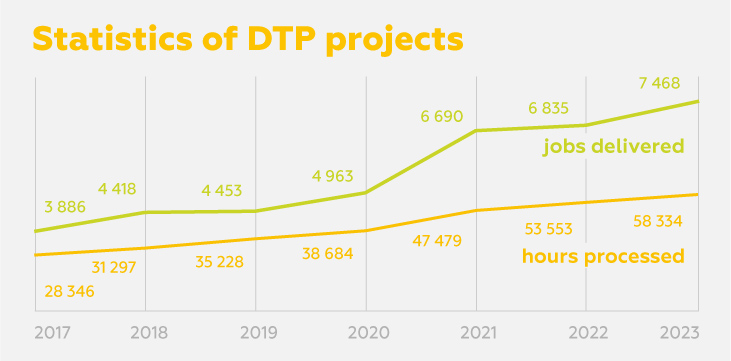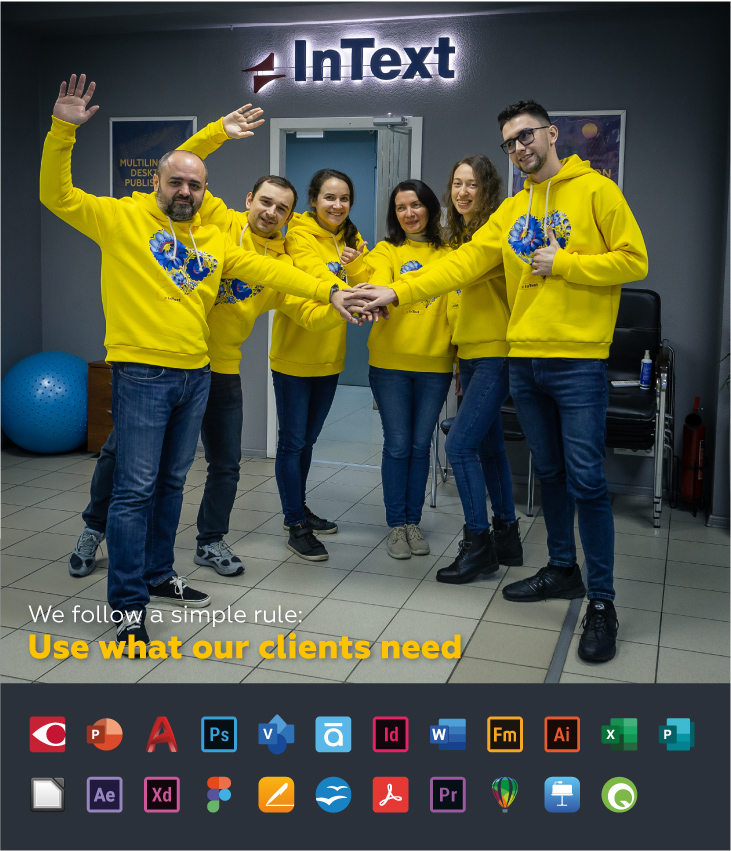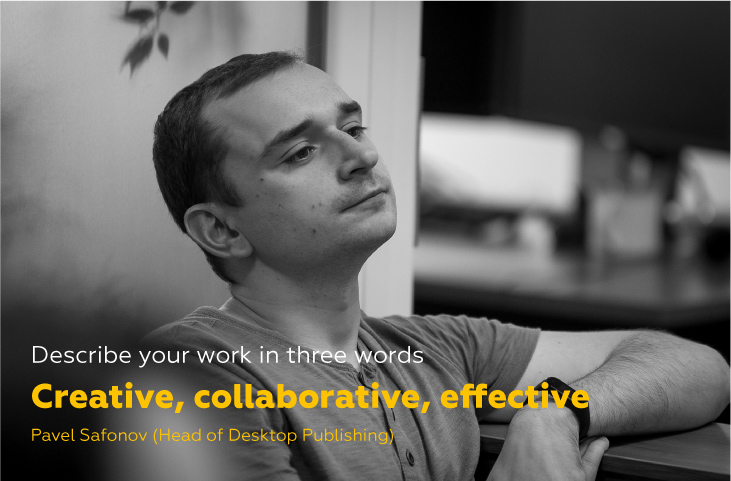In this article, we address several questions we have heard at industry conferences and in the media during the past year. InText COO Kirill Fedotov and Pavel Safonov, Head of Desktop Publishing, discuss what InText does in the challenging and highly competitive market to make sure that our clients benefit from our quality desktop publishing services.
At the end of the article, we share a free checklist that will be helpful both for language service providers and internal localization teams.

Kirill: Desktop publishing is the process of preparing any type of file for translation and creating the correct layout in every language afterward. Multilingual DTP is primarily used for engineering drawings, process flowcharts, brochures, books, newsletters, eBooks, magazines, technical manuals, posters, presentations, packaging labels, flyers, and handouts when they need to be translated into other languages. At InText, we include video editing, e-learning preparation, and graphic design from scratch within our desktop publishing offerings, as these services are complementary and performed by the same team of experts.
Pavel: We know for sure what DTP is, as InText has been providing DTP services for the last 20 years. We continually increase the desktop publishing department’s capacity, and we currently have eight in-house and 40+ freelance DTP specialists. Every day, our project managers process dozens of DTP orders, while our department consistently improves its skills, mastering new tools.

Pavel: Ten years ago, I started my career in localization as a freelance desktop publishing specialist. I specialized in AutoCAD projects, as I had experience working with such software for engineering. Over time, I have mastered a wide range of tasks and applications. After joining InText as a full-time in-house DTP coordinator, I was responsible for evaluating and distributing orders.
Kirill: My path into the localization business began almost 20 years ago, when I combined many different functions, including preparation and layout formatting. I mostly worked as a project manager, and there was no separate document processing role in our company. I did all things personally: file conversions, text recognition, file preparation for CAT tool compatibility, formatting of text layouts after translation, etc.
Kirill: There are different trends. On the one hand, according to reports from CSA and Nimdzi, the global localization market is growing and there will be more and more content in the future. DTP is an integral part of making and sharing content, so the volume of DTP content will continue to expand. On the other hand, continuous digitalization moves a lot of content to the web, simplifying its transformation for various locales. You need much less preparation and layout formatting for the web, or you need a layout of a completely different kind.
One major disruptor of the localization industry is AI, and we have recently published an article about AI trends in optical character recognition, or OCR, which is a crucial part of DTP services. You can read it on our blog or in Multilingual magazine.
Kirill: During the rise of globalization, businesses wanted to extend, and they were looking for sales outside their locales. Often, growth of global trade boosted demand for localization. At the same time, when you localize texts, you still need to implement them in physical or digital form. That’s when DTP comes into place.
Going global requires content adaptation and, thus, DTP. As borders, blocks, and barriers to trade occur now and will continue to in the near future, it harms the physical trade of goods, but digital trade will still be widely used.
Kirill: It depends on the use cases. For example, optical character recognition is a crucial part of desktop publishing services, consisting of file type conversion, normalization, recreation, and text extraction. If you’re looking for an OCR solution, you will find one list of tools. If you require document layout formatting, image or drawing localization, e-learning adoption, or video or multimedia customization, there will be separate lists. I can surely say there is no magic tool covering all requirements. You need to master many different tools to work effectively and provide the best quality for your clients and end consumers of the content.

Kirill: Plan-Do-Check-Adjust. This never-ending cycle is at the heart of our quality management system. The rest of the system involves keeping records. Records are kept at various levels: business processes, standards, instructions, route sheets, checklists, etc. Our quality management system is a big machine driven by the software tool, which we developed for ourselves. This tool helps us select the right specialist for each job, provide them with the necessary documentation, and assign a qualified checker. You can only control what is written. We write down a lot of information in our records and thus ensure all customer, project, language, and cultural requirements are followed.
Pavel: In the middle of 2023, we got a highly challenging project. There was a huge number of pages (thousands) coming from several customers all at once. The task was to convert them from PDF into DOCX for further processing with CAT tools. Deadlines were very tight. We had to double our normal productivity for one month, delivering batches every day. We engaged all reserves and implemented new technological solutions. For example, we fully automated the process of transferring files from DTP operators to DTP checkers.
Kirill: From my point of view, our key success factors are motivated people, well-tuned procedures, and automated processes. The DTP department has a long story: it started from an idea, then grew to a couple of professionals dedicated to the task, and now it is a super team of eight in-house employees plus several dozen full-time remote operators. The volume of DTP tasks has been escalating since the beginning, and now we have achieved and exceeded a fantastic result of 60,000 hours per year. It means that a team of 30 people works simultaneously eight hours each weekday of the year. Not bad, right? Beyond that, the overall quality of deliverables is very high — we register as low as one to two cases per 1000 orders when quality is considered inappropriate. When issues do occur, we analyze each case to see what happened and prevent the same issue from occurring in the future.
Kirill: It all comes from the InText corporate culture. If a company can hire the right people, fostering the right culture is not a problem. I suppose we can and do hire the right people according to our results.
Pavel: We achieve it through a culture of openness, trust, and support. It lets the team feel comfortable and safe, sharing their ideas and opinions, helping each other, and learning from each other. Such an environment fosters efficient teamwork and professional development.
Kirill: Yes. I would mention two major things here. One is our own set of special Visual Basic for Applications (VBA) macros and scripts for MS Word that boost formatting productivity. Another development is in our vendor assignment processes: we have created a self-developed chatbot and our own tailored Project Management System software (desktop and web versions). Programming skills are required to develop and support these automation tools, and we do have several software developers on staff.
Kirill: Delightful, transforming, productive (known as DTP) :)

Pavel: Creative, collaborative, effective.

Our team is not only highly motivated and involved in collaborative teamwork but also optimistic about prospects. Market conditions remain tough and technology continues to evolve, but the key to success remains the same — to build and grow a professional team that continues learning every day and to pay as much attention to your clients’ needs as possible at every stage.
To give you a hand, Kirill and Pavel have prepared a special checklist for InDesign translation projects (one of their “secrets to success”). It will come in handy for anyone thinking about ordering DTP services. In fact, our own managers who work on desktop publishing projects use it every day!
Stay tuned for further updates from InText. And if you have any questions, feel free to visit dtp.intext.com or email us at localize@intext.com.